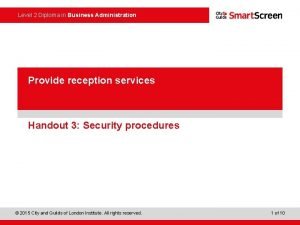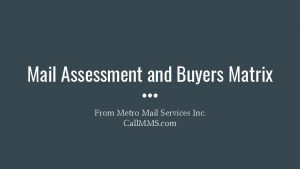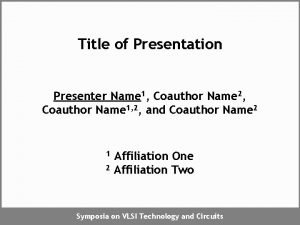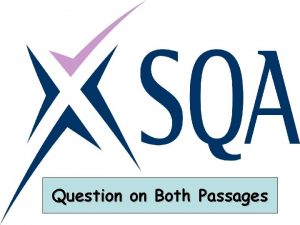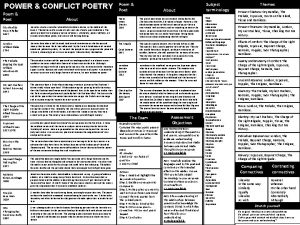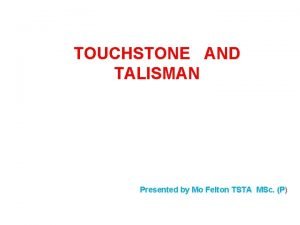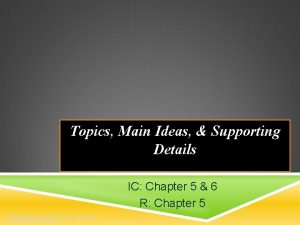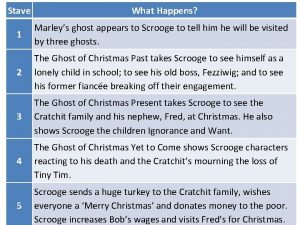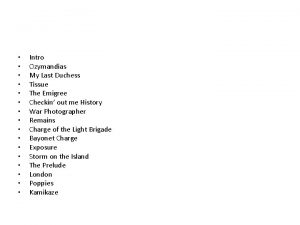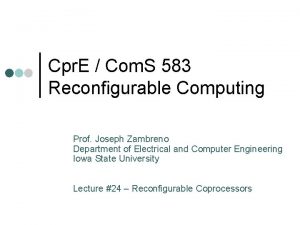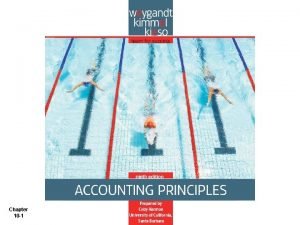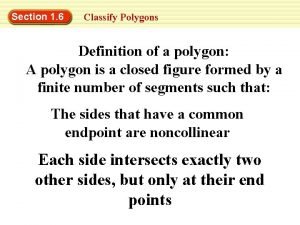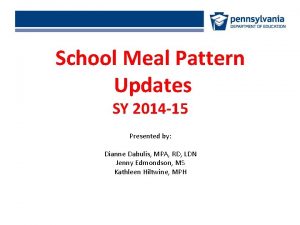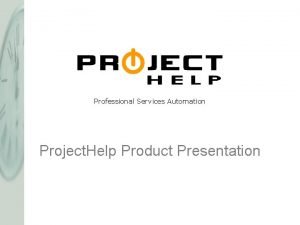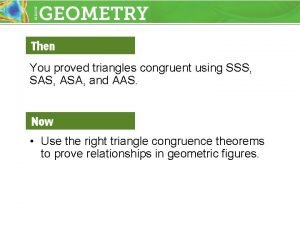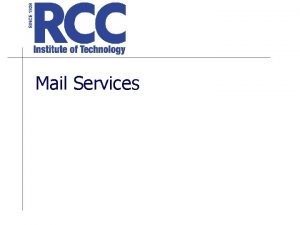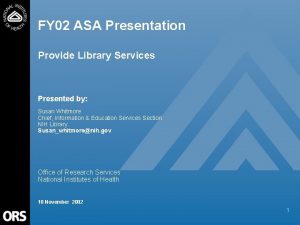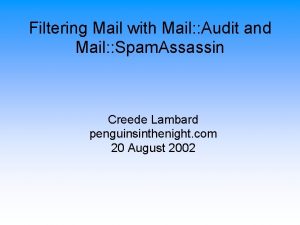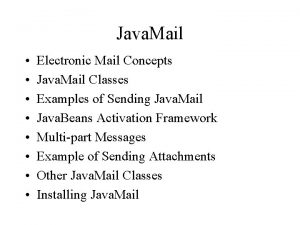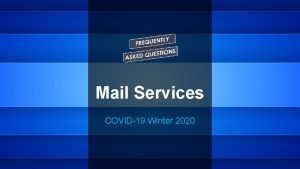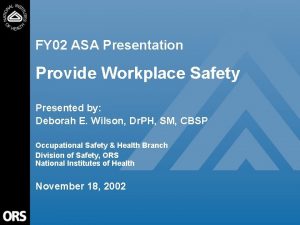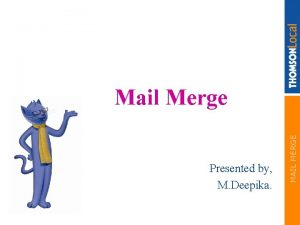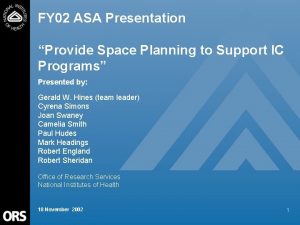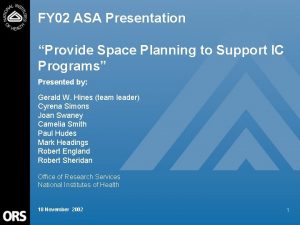FY 02 ASA Presentation Provide Mail Services Presented



















































- Slides: 51

FY 02 ASA Presentation Provide Mail Services Presented by: James V. Spears Team Members: Angela Milton Tracy Niksich Office of Research Services National Institutes of Health 18 November 2002 1

2

Customer Perspective 3

DS 1: Customer Segmentation Process and Deliver Incoming Mail 4

DS 1: Customer Segmentation Process and Deliver Incoming Mail • 21% NIH buildings (18 of 85) accounted for 80% of all mailstops • 32 buildings account for only one mailstop each • mailstops are not evenly distributed among buildings • The average number of mailstops per building is 13. 3 5

DS 1: Customer Segmentation Process and Deliver Incoming Mail • Fewer mailstops per building means that mail delivery is more time consuming than if the mailstops were distributed among fewer, larger buildings • Mail comes to NIH from around the world • impossible to formally document the primary sources of mail. 6

DS 2: Customer Segmentation Perform Mail Directory / Locator Service 7

DS 2: Customer Segmentation Perform Mail Directory / Locator Service • The volume of directory mail stays proportionate with the volume of first class mail • On a monthly basis, any differences in directory mail generation by different first class mail types (e. g. Fed. Ex bills, Christmas cards, etc. ) cancel each other out • Directory services are only performed after the incoming mail volume has been processed for delivery and does not increase variable costs 8

DS 3: Customer Segmentation Process and Dispatch Outgoing Mail 9

DS 3: Customer Segmentation Process and Dispatch Outgoing Mail • 16% of NIH postage accounts (9 of 56) accounted for 80% of all postage used • 55% of NIH postage accounts (31 of 56) accounted for only 3% of all postage used • Outgoing mail has priority only after all incoming mail has been dispatched for delivery at 12: 30 p. m. • All Outgoing mail is processed daily before USPS pick-up. 10

DS 4: Customer Segmentation Process and Deliver Inter-Office Mail 11

DS 4: Customer Segmentation Process and Deliver Inter-Office Mail • 21% NIH buildings (18 of 85) accounted for 80% of all mailstops • 32 buildings account for only one mailstop each • Inter-Office mail is processed separate from incoming mail when processed for delivery • Inter-Office mail cannot be tracked by source as Inter-Office mail lacks a return address • All Inter-Office mail is processed daily 12

DS 5: Customer Segmentation Management of Postal Accounting System 13

DS 5: Customer Segmentation Management of Postal Accounting System • 16% of NIH postage accounts (9 of 56) accounted for 80% of all postage used • 55% of NIH postage accounts (31 of 56) accounted for only 3% of all postage used 14

Customer Satisfaction (Poll) • 20. 4% rate of return (224 of 1100) • The range of the rating scale was from A (excellent) to E (poor) in order to keep the grading system familiar to respondents • Scoring was done on the collegiate system (e. g. A=4. 0, B=3. 0, etc. ) • The overall mean score (excluding N/A responses) of 3. 0 is equal to a “B” (very good) 15

Customer Satisfaction (Poll) 16

Customer Satisfaction (Poll) Poll Analysis By Question: Percent “C” (Acceptable) or better 17

Customer Satisfaction (Poll) Poll Analysis By Question: Percent “C” or better 18

Customer Satisfaction (Poll) Poll Analysis: • Low scores given for Question 2 were nearly all related to Question 2 c (per their comments) • Many complaints from Question 2 c were due to a misconception among some employees concerning positional mail • Complaints from Question 4 were primarily concerned with slower delivery of poorly addressed interoffice mail (e. g. see following slide) 19

Customer Satisfaction (Poll) (cont. ) 20

Customer Satisfaction (Poll) Poll Analysis: • The lower than average mean score (2. 68) for Question 6 was not unexpected, this is the most difficult mail type to process to intended recipient • The 88% “C” or better for Question 6 shows that most of our customers understand that this mail is difficult to process and they feel that we are doing an acceptable to excellent job with it 21

Reduce Customer Complaints Regarding Missorts 22

Reduce Customer Complaints Regarding Missorts • There is no source pattern to the complaints as they are addressed immediately with corrective action and verified continuously for several weeks to be certain the problem is solved 23

Internal Business Process Perspective 24

Block Diagram: Provide Mail Services Discrete Services for MCSB: • Are sequential in nature • Cannot be performed out of order • Must all be performed on a daily basis 25

Conclusions from Discrete Services Deployment Flowcharts • Our Service Group completed Five deployment flowcharts for Five discrete services • Production of the deployment flowcharts, and verification by sorters confirmed that management’s perception and understanding of the process workflow was correct and complete. • MCSB Management monitor every step of the work-flow process for standards compliance 26

Process Measures List process measures for each discrete service • • • DS 1 -1: Time of day at route midpoint DS 1 -2: Error Rate from Random Samplings DS 3: Error Rate from Random Samplings DS 4: Error Rate from Random Samplings DS 5: Dollar savings vs. Postal OMAS statement 27

Process Measure Results Findings from process measures data: DS 1: Process and Deliver Incoming Mail • Control Charts showed that the driver delivery times were consistently within normal variation when regular drivers were present • Random Samplings from clerk sortation showed a 1. 06% initial error rate for September. DS 2: Perform Mail Directory/Locator Service • Random samplings showed no clerk lookup errors 28

Process Measure Results Findings from process measures data: DS 3: Process and Dispatch Outgoing Mail • Random Samplings of meter-stamped outgoing mail showed a 0. 21% error rate for September. All errors were from one day. Cause of error was failure to apply oversize surcharges where needed DS 4: Process and Deliver Inter-Office Mail • Random samplings of inter-office mail showed no clerk sortation errors. 29

Process Measure Results Findings from process measures data: DS 5: Management of Postal Accounting System • $8, 748, 000 savings vs. OMAS statement by disputing unauthorized charges from USPS and other sources since 1992. 30

Learning and Growth Perspective 31

Conclusions from Turnover, Sick Leave, Awards, EEO/ER/ADR Data Turnover: • Turnover is expected to become an issue for MCSB in the near term • Turnover will be less of an issue in the longer term, due to increased outsourcing of duties within MCSB Sick Leave: • MCSB has the lowest sick leave usage of any Service Group in the study, despite having one employee on long-term sick leave during the whole of the study period. This is due to high morale and dedication 32 to duty within MCSB

Average Hours of Sick Leave Used Average Hours (Oct 2001 - June 2002) Service Group Number 33

Conclusions from Turnover, Sick Leave, Awards, EEO/ER/ADR Data Awards: • By giving awards where deserved and spreading them fairly between Management and Clerk employees, MCSB has created a high-morale environment EEO Complaints: • MCSB EEO complaint average was based on only one complaint. This was due to the termination of an employee who was trying to avoid this management action. 34

Conclusions from Turnover, Sick Leave, Awards, EEO/ER/ADR Data ER: • MCSB ER average is higher than the MCSB ADR average, due to the fact that MCSB counsels employees and provides numerous opportunities for reform before taking corrective action ADR: • MCSB ADR average was higher than would normally be expected due to the efforts of two employees who were trying to avoid progressive corrective action and 35 eventually, termination.

Analysis of Readiness Conclusions • All major skills and abilities required by MCSB are present among current employees • MCSB is currently short by six positions. It is expected that these positions will be filled through outsourcing • Since 850, 000 sq ft of NIH lab space is expected to be created over the next three years, MCSB must be prepared to constantly reexamine its’ needs and to amend the current mail services contract, as needed • MCSB must continue to promote safety / security awareness, teambuilding, and computer skills through the use of available training classes to keep employee skills up-to-date • MCSB must begin to analyze options for replacing it’s Pitney-Bowes Paragon® postage machines to ensure best value for NIH 36

Financial Perspective 37

Unit Cost Measures Analysis: • “Process / Deliver Incoming Mail” – Cost per hour is relatively stable, but dependent on set wage rates • “Mail Directory / Locator services” – No direct variable costs associated • “Process and Dispatch Outgoing Mail” – No direct variable costs associated • “Process / Deliver Inter-Office Mail” – No direct variable costs associated 38

Unit Cost Measures Analysis: • “Manage Postal Accounting System” –Postage costs by IC must be tracked to • properly attribute time and costs • accurately assess IC’s for next Fiscal Year • ensure accurate USPS billing 39

Asset Utilization Measures 40

Asset Utilization Measures Analysis: Idle Capacity: • The daily weekday period between 5: 00 p. m. and 7: 00 a. m. (14 hours), and Saturday-Sunday, represents the weekly operational Idle Capacity. • This idle capacity is not marketable. • The operation is not staffed during this period. • due to security concerns, the area 41 must have restricted access

Asset Utilization Measures Analysis: Non-Productive Capacity: • Standby time is minimal • Due to the flexibility of our operation there is no waste of time resources. • Rework due to sorting errors is very small. • Scheduled Maintenance occurs only during those times when equipment is 42 not expected to be in use

Unique Financial Measures Reduce Dollar Amount of USPS (OMAS) Billing Errors: • MCSB records from the last 10 years show that $8, 748, 000 has been recovered, to date, from the USPS and other sources as a result of MCSB-initiated billing inquiries • Results from the careful record keeping and management of the postal accounting system by MCSB 43

Unique Financial Measures 44

Conclusions and Recommendations 45

Conclusions from FY 02 ASA Major Findings: • Deployment flowcharts confirmed that management’s perception and understanding of the process workflow was correct and complete • Process perspective studies show that delivery times are consistent within normal variation when regular delivery drivers are present 46

Conclusions from FY 02 ASA Major Findings: • Random samplings showed no or low error rates for the process perspective of DS 1 - 4 • DS 5, Management of the Postal Accounting System has been very effective in preventing waste 47

Conclusions from FY 02 ASA Major Findings: • MCSB is prepared for the near term with regard to employee skills • MCSB has high morale and dedication, as evidenced by having the lowest sick leave usage rate in the group studied • MCSB must be prepared to constantly reexamine its’ needs and to amend the current mail services contract, as needed in order to meet needs created by future growth 48

Conclusions from FY 02 ASA Countermeasures begun: • MCSB has begun contacting those respondents to our poll who showed concern over mail forwarding. MCSB representatives will explain the rules and regulations concerning positional mail and mail forwarding • MCSB is preparing a fact sheet on positional mail to be distributed to all mailstops at a future date 49

Recommendations • • That MCSB move forward with its educational campaign to explain about positional mail and forwarding That MCSB continue to monitor delivery driver standards to ensure consistency of delivery both on and off campus 50

Recommendations • • That MCSB continue to take random samplings of work that forms our discrete services to ensure quality and compliance with standards That MCSB continue to review the USPS OMAS billings and recover funds where NIH has been billed in error 51
 Don would always open the mail throw away the junk mail and
Don would always open the mail throw away the junk mail and Priority mail vs priority mail express
Priority mail vs priority mail express Google docshttps://mail.google.com/mail/u/0/#inbox
Google docshttps://mail.google.com/mail/u/0/#inbox What are the services delivered by a valet
What are the services delivered by a valet Service housekeeping request
Service housekeeping request Provide reception services
Provide reception services Metro mail services
Metro mail services Mail recovery services
Mail recovery services Uwaterloo email setup
Uwaterloo email setup Subhead in newspaper
Subhead in newspaper Presentation by name
Presentation by name When is jekyll and hyde set
When is jekyll and hyde set Romeo and juliet themes love
Romeo and juliet themes love Which idea is presented in both passages?
Which idea is presented in both passages? Presenter's name
Presenter's name Juxtaposition in ozymandias
Juxtaposition in ozymandias Cognitive learning theory was presented by
Cognitive learning theory was presented by Hyde as a frightening outsider
Hyde as a frightening outsider Talisman presented
Talisman presented Topic, main idea supporting details
Topic, main idea supporting details What is the poem kamikaze about
What is the poem kamikaze about Technological design loop
Technological design loop Bob cratchit quotes
Bob cratchit quotes Text
Text Introduction to conic sections
Introduction to conic sections Ozymandias and london venn diagram
Ozymandias and london venn diagram Prism is presented with
Prism is presented with Cause/effect text structure
Cause/effect text structure Technical drawing and artistic drawing
Technical drawing and artistic drawing How are the events in the text presented
How are the events in the text presented Proudly presented to
Proudly presented to She should have died hereafter macbeth analysis
She should have died hereafter macbeth analysis Macbeth scene 4
Macbeth scene 4 Depletion journal entry
Depletion journal entry As presented below
As presented below Polygon presented
Polygon presented Krispy kreme vs dunkin donuts
Krispy kreme vs dunkin donuts How is lev presented in significant cigarettes
How is lev presented in significant cigarettes Presented sy
Presented sy The kitchen presented by
The kitchen presented by Professionally presented
Professionally presented Caltech bursar
Caltech bursar The element of music that organizes movement in time is
The element of music that organizes movement in time is How it's made presented by
How it's made presented by The three plant asset disposal methods
The three plant asset disposal methods Fetal lie
Fetal lie Vertex presentation
Vertex presentation Managed services sales presentation
Managed services sales presentation Professional services presentation
Professional services presentation Integrated services vs differentiated services
Integrated services vs differentiated services Wake county human services community services center
Wake county human services community services center Flow proof geometry
Flow proof geometry





